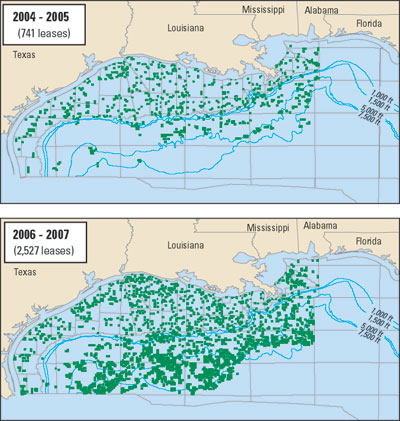What's new in exploration
An interesting report.Deepwater Gulf of Mexico 2004: America's Expanding Frontier, was issued by the US MMS this summer. One of the more noteworthy findings was that there are thousands of deepwater leases about to expire. This is due to the record number of leases acquired in the acreage rush during 1995 – 1998.
In the absence of primary lease-term extensions, all active shallow-water leases will expire before 2010, in part because lease terms for blocks in less than 400 m (1,312 ft) of water only last five years. In contrast, deepwater blocks last eight years in 400 – 799 m (1,312 – 2,622 ft) waters, and 10 years in 800 m (2,625 ft) depths. Soon, deepwater blocks will see:
Without lease-term extensions, which will likely be rare, there will be about 3,300 leases becoming available. Because the GOM deepwater is already heavily leased, these expirations will considerably influence future lease sales. Most companies can only drill a small percentage of their active leases, so it is likely that many high-quality leases will expire without being tested. This situation often results in farm-out opportunities for non-majors and, possibly, more rapid exploration and development of the acreage. Ultimately, an untested and undeveloped lease will expire, and perhaps be leased again. Exploratory drilling in the GOM peaked at 118 wells in 1998. Thereafter, it declined: 102, 100, 114, 83, and 68 for the years 1999 through 2003, respectively. The reason for the nearly 50% decline is unclear. Part of it is probably due to deeper drilling depths, which are more costly and require greater care and planning, and thus more time. Part of it could be due to the lack of a classification standard that companies use for classifying their wells as exploration or development. First fiber-optic seabed seismic. Four major oil companies will test a prototype of the world's first multicomponent fiber-optic seabed seismic acquisition system for monitoring offshore hydrocarbon reservoirs. The new system should be ready for testing by year-end 2004. It is being developed under an Anglo/ US JIP that is funded by BP, ChevronTexaco, ConocoPhillips and Shell. The project is managed by UK-based QinetiQ in partnership with Input/ Output Inc., which is based in Texas. The multicomponent fiber optic system being built will be fully optical and without any electronic components. It is hoped that such a system will provide the cost breakthrough required to accelerate the adoption of permanent reservoir monitoring systems on the seafloor. Unusual Caribbean activity. Jamaican state oil company, PCJ, plans to launch the island's first ever international oil and gas exploration tender round by December 1. Bidding rules will be available January 1, 2005. Bids must be submitted by July 15. The tender is for 22 offshore and 4 onshore blocks, covering the entire Jamaican region. Jamaica issued a statement that it intends to offer exceptionally good terms to companies. The exploration licenses are for a period of five years and, if oil and gas are found, production-sharing contracts with the government would be for 20 – 30 years, according to the news service BNamericas. The government statement said that to date, 53 structures have been identified offshore in “modest” water depths, and that, of the 11 exploration wells drilled so far (2 onshore, 9 offshore), 10 had oil and/or gas shows. The state oil company of Suriname and Danish oil company Maersk Oil signed a PSA in November for offshore Block 31, located 19 mi off the Suriname coast. The contract is a set at 30 years and is divided into exploration, development and production periods. Because a seismic boat is already in Suriname collecting data for Repsol-YPF, the work may begin immediately following the signing. Maersk Oil is a part of the A.P. Moller – Maersk Group, also known for their shipping activities. Abbrevidiculous! While editing an article for this issue, this editor, overly abbreviated the following paragraph: “In the US, the MMS recently issued its programmatic EA for G&G operations in the GOM. This EA, which began in 1999, recently concluded with an FONSI. While initially reassuring to many in the E&P industry, NOAA Fisheries, who is the ultimate regulator under the MMPA, has already indicated that an EA is not adequate under the NEPA, and that they intend to develop an EIS as the NEPA document for the upcoming G&G rulemaking in the GOM.” After a first read, I realized my error and rewrote it to be readable. Without any derision toward the author whatsoever, in addition to pointing out the editor's zeal to be succinct, it also epitomizes the state of regulation of marine mammals. The paragraph could have been even worse. There are so many government agencies, acts, laws, regulations, treaties and other international agreements, that paragraphs such as this are inevitable. If you wish to decipher it, click here.
|
|||||||||||
- Prices and governmental policies combine to stymie Canadian upstream growth (February 2024)
- U.S. producing gas wells increase despite low prices (February 2024)
- U.S. drilling: More of the same expected (February 2024)
- U.S. oil and natural gas production hits record highs (February 2024)
- Quantum computing and subsurface prediction (January 2024)
- U.S. upstream muddles along, with an eye toward 2024 (September 2023)
- Applying ultra-deep LWD resistivity technology successfully in a SAGD operation (May 2019)
- Adoption of wireless intelligent completions advances (May 2019)
- Majors double down as takeaway crunch eases (April 2019)
- What’s new in well logging and formation evaluation (April 2019)
- Qualification of a 20,000-psi subsea BOP: A collaborative approach (February 2019)
- ConocoPhillips’ Greg Leveille sees rapid trajectory of technical advancement continuing (February 2019)





